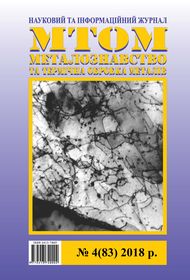Ways of compensationof incomplete formal axiomatics in identification ofcomplex objects
DOI:
https://doi.org/10.30838/J.PMHTM.2413.261218.31.562Keywords:
incompleteness of formal axiomatic, complex object, fractal geometry, the principle “external additions”, cast iron,Abstract
Abstract. Introduction.The discrepancies between the results of modeling and the data obtained after direct experiments on a real object indicate incompleteness of the formal axiomatics of the existing methods of research in various fields of science and technology. To assess the incompleteness of the formal axiomatics of the object, the theorem of K. Godel and the principle of “external complementing of S. Bir” are used. In purpose to compensate for the incompleteness of formal axiomatics, it is proposed to perform modeling of the microstructure of an object with the use of a language of a higher level. Theoretical basis and results.As an example, the cast iron structure represented by the fractal model is considered. Comparison of the analysis results of the structure and mechanical properties of cast iron with the use of fractal and traditional methods with field testing data is carried out. The correlation coefficients between the topological characteristics of the structure of cast-iron rolls of the brand SPHN (percentage content of perlite and carbides) and mechanical properties are 0,53and 0,52, respectively. Between the fractal dimensions of perlite and carbides and the mechanical properties of these rolls, the coefficients of correlation make up 0,94 and 0,93, respectively. The obtained results indicate the prospects of using fractal geometry for the identification of complex objects in comparison with the Euclidean geometry. Originality. In order to partially eliminate the incompleteness of the formal axiomatics that arises when identifying the structure and properties of complex objects, according to the principle of “external addition”S. Bier, it is shown that it is possible to apply a higher level language fractal geometry. Conclusion. An algorithm is proposed for partial compensation of the incompleteness of the formal axiomatics of the structure of complex objects using fractal modeling. The results obtained highlight the prospects of using the fractal geometry to partially compensate for the incompleteness of the formal axiomatics in the model under consideration.
References
Downloads
Published
Issue
Section
License
Authors that are published in this journal agree to follow the conditions:
Authors reserve the right to the authorship of his work and cede the right to the journal of first publication of this work on conditions of the license under the Creative Commons Attribution License, which allows others to distribute it freely with the obligatory reference to the author of the original work and the first publication of the work in this journal.

